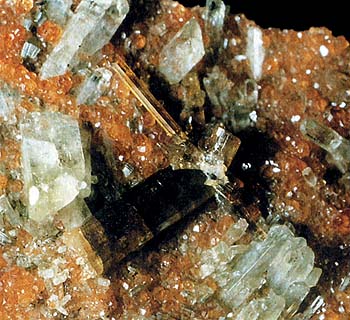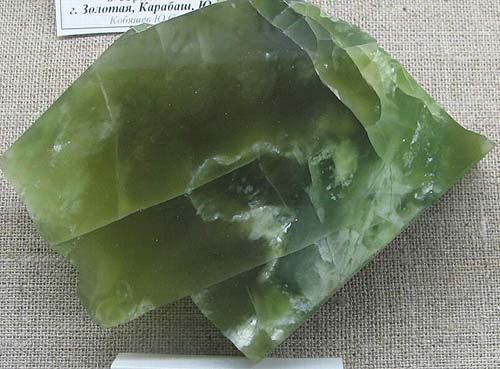Epidotes (silicates): Vesuvian (idocrase, viluit)
 Diagnostic card.
Diagnostic card.
On the picture. Crystals vesuviana: if the mineral has no impurities, it is colorless.
Ca 10 (Mg, Fe) 2 Al 4 (OH) 4 (SiO 4 ) 5 (Si 2 O 7 ) 2
Tsingonia tetragonal
Hardness 6,5
Specific weight 3.27-3.45
Cleavage is poor
Cracked shell
Color is colorless, differently colored
Color in powder white
Gloss from glass to resin
Vesuvian got its name from the place of discovery - in the lavas of Vesuvius, its synonym Viluite is also associated with the place of detection - in the traps on Vilyui, and the synonym of idolakis originated from the Greek krasis - a mixture: the crystals of this mineral are composed of a combination of many simple forms (faces). It occurs in Canada, the CIS, the USA.
California (the location of the find) is called a fine-grained bright green variety, also found in Pakistan, cyprin is blue vesuvian from Norway.
Vesuvian, or idocrase, viluite. Complex silicate of calcium, magnesium and iron. Glitter glass to greasy. It is transparent. Colors: olive green, greenish-yellow, gray, brown, reddish-brown. The line is white. The fracture is uneven, stiff. Cleavage is imperfect. It is formed in metamorphosed carbonate rocks. The crystals (tetragonal syngony) are short-columnar, acicular, and also granular, dense aggregates. Occasionally used as an ornamental stone. Distribution: Vesuvius (Italy), Wallis (Switzerland), Czech Republic, Mexico, in the CIS - Vilyui.
The shape of the crystals of vesuvian is variable - from tabular and bipyramidal to short-prismatic and acicular. It is a solid mineral, which with great difficulty separates in cleavage. Occasionally there are transparent crystals; Shine from glass to resin; Hatching is often observed on the ends along the faces. The color varies from greenish-yellow to brown, with a pinkish haze; Less often it can be yellow, violet-red or greenish-blue. Color is determined by the presence of elements such as iron, copper, titanium and manganese.
 Vesuvian is a mineral, calcium and aluminum silicate of complex composition. Vesuvian crystals often have a columnar, prismatic or pyramidal shape. At the same time, when you look at large enough crystals of vesuviana, it seems that they are composed of simple geometric bodies joined together - cubes, as if welded, mixed with each other. Hence the other name of this mineral, formed with the help of the roots of the Greek language, is idocrase (Greek crasys - "mixture"). Under this name, vesuvian is known since 1796. The color of the vesuvian is greenish-yellow, brown, bottle green, occasionally emerald green; Coloration is due to an admixture of iron, resistant.
Vesuvian is a mineral, calcium and aluminum silicate of complex composition. Vesuvian crystals often have a columnar, prismatic or pyramidal shape. At the same time, when you look at large enough crystals of vesuviana, it seems that they are composed of simple geometric bodies joined together - cubes, as if welded, mixed with each other. Hence the other name of this mineral, formed with the help of the roots of the Greek language, is idocrase (Greek crasys - "mixture"). Under this name, vesuvian is known since 1796. The color of the vesuvian is greenish-yellow, brown, bottle green, occasionally emerald green; Coloration is due to an admixture of iron, resistant.
Vesuvian got its name at the site of the first find - the slope of the volcano Vesuvius (Italy). Synonyms: agate glass, vesuvian greed, viluite, false hyacinthin, American greed, vesuvian greed, idocraz, wiluysky emerald, Californian, American jade, volcanic chrysolite, Italian chrysolite, commercial chrysolite. Chemical composition - content: СаО - 33 ч37%; Al2O3 -13.16%; Si02 - 35h39%; Н20 - 2-3; Impurities of potassium, sodium, lithium, manganese, strontium, chromium, titanium, beryllium, boron are noted. Singonia is a tetragonal, di-tetragonal-di-pyramidal symmetry. Cleavage is practically absent, sometimes unclear by (110), (100), (001).
Diagnostic signs.
It is difficult to hydrochloric acid. In the flame, the candles melt easily, forming a foamy glass of brown or light green color.
Origin.
Vesuvian is a typical mineral of limestone-dolomite rocks, exposed to contact metamorphism when they come into contact with intrusions during their hardening. In addition, it is formed in rodingites, which are part of the serpentinite formation.
Place of Birth.
The most significant deposits, in which there are transparent differences of vesuviana, are located in Canada, Pakistan, Kenya and Mexico. The rarest variety, greenish blue cyp-rin, is found in Norway and in New Jersey (USA), and another species, green dense California, except California, is found in Quebec (Canada) and Russia. In Italy, among the locations known for their magnificent but usually fine crystals, we note Vesuvius (Naples province), Val d'Ala (Turin province), Valle della Gava (province of Genoa), Val Malenco (Sondrio province ), Valdi Fassa (province of Trento) and Pitigliano (Grosseto province).
On the territory of the province of Quebec in Canada there are vesuvianes of jewelry quality of 10-15 carats. Vesuvianes are also found in Norway, Italy, Switzerland, Pakistan and Africa. For samples of vesuviane, Russians do not need to go to Italy or America. Beginning in 1914, the vesuviane of the Urals was studied by the Russian professor SM Kurbatov. The result of these studies was his book "Vesuvianes from the Russian deposits." In the early 80's. XX century. This mineral was also found on the slopes of the "failed" Ayudag volcano in the Crimea.
Application in jewelry.
Transparent Vesuvian is divided into steps, in rectangular or square form. Polished fragments of californite are used in jewelry for making various crafts or are cut into cabochons. In the jewelry business for the cutting and insertions in the decoration used transparent samples of brown with about. Sri Lanka.

Vesuvian ("vesuvian greed"). Tas-Hayakhtah tree, Paul. Yakutia, Russia. Photo: © А.А. Evseev.

Vesuvian (viluite). Viluy r. At the confluence of p. Akhtaranda, Yakutia, Russia. Photo: © А.А. Evseev.
- Ghetchellit - "New Almaden blend" - arsenide and antimony sulfide (modern sulfosol)
- Antimony is a toxic metal (semimetal) , widely used in metallurgy, medicine and engineering
- Zirconium - a rare and undiscovered metal and the most dangerous precious stone in oxide and salt
- Gold - yellow dangerous and poisonous metal of modern accurate digital and cable technologies
- Sulfur is a golden-yellow toxic substance and a sign of active volcanic activity
- Cadmium is an undisputed toxic silvery metal unknown to a wide range of people
- Lead - a poisonous gray imitator of metallic silver and toxic metal blende
- Arsenic is a classic poison of medieval and modern poisoners and medicine in medicine
Poisonous and radioactive dangerous stones and minerals
** - poisonous stones and minerals (mandatory check in the chemical laboratory + explicit indication of toxicity)
** - radioactive stones and minerals (mandatory check on the standard dosimeter + ban on open sales in case of radioactivity exceeding 24 milli / g / h + additional measures of population protection)
Catalog of minerals and semi-precious stones of the world by groups
** - poisonous stones and minerals
** - radioactive stones and minerals


Comments
Commenting on, remember that the content and tone of your message can hurt the feelings of real people, show respect and tolerance to your interlocutors even if you do not share their opinion, your behavior in the conditions of freedom of expression and anonymity provided by the Internet, changes Not only virtual, but also the real world. All comments are hidden from the index, spam is controlled.